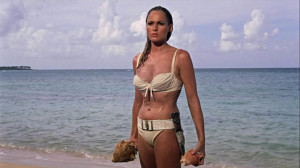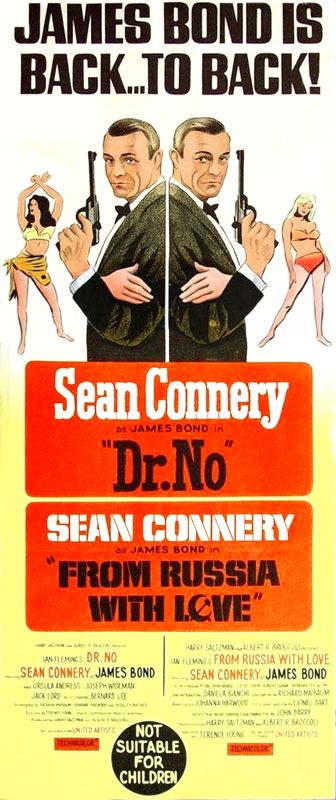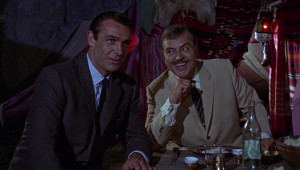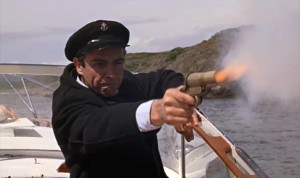With Spectre, the 24th installment of the long-running James Bond franchise, hitting theaters this November, we’re taking a weekly look back across the entire series and charting its changes across its five decades. First up is the Bond series’ first two installments – Dr. No and From Russia With Love.
 Dr. No
Dr. No
Dr. No does not spring forth with the Bond franchise formula fully in place, but boy is it close.
The familiar gun barrel opening to the credits is here, but the majority of the titles play out against an animated series of blinking, multi-color dots that seem to suggest computers and feels more like the pop art-influenced work of Saul Bass than that which Maurice Binder would become famous for supplying to the series. Interestingly, not one but three songs play across the opening credits, making the music function more like an overture previewing the many musical themes that would be in play on the soundtrack. It wouldn’t be until Goldfinger that the film’s title theme would be paired with the opening titles.
In the plus column, Connery’s introduction in the film, in full tux playing cards at his London club, has him embodying the character almost immediately. Still, knowing that producers Albert R. Broccoli and Harry Saltzman had originally gone after Cary Grant for the role of 007 for the film, it is hard not to imagine what they were after when they pursued him for the role.
While the work was shaped and overseen by Saltzman and Broccoli and by Bond’s literary creator Ian Fleming, director Terence Young and co-screenwriter Richard Maibaum also deserve some recognition in shaping what Fleming once described as “a blunt weapon used by a government agency” into the suave superspy of the silver screen. Young would stick around for two more films – the first Dr. No follow up From Russia With Love and then 1965’s Thunderball, while Maibaum would contribute to a total of 13 Bond films.
 Interestingly, although the film was shot in right as the Cold War was beginning to heat up, Dr. No’s employers were switched from the Soviet Union of Fleming’s original novel to the fictional terrorist organization SPECTRE. In hindsight it is an acceptable change as it has given the franchise an adversary which will haunt (pun intended, sorry) 007 with dire consequences for several films to come. It is probably one of the most overt changes to the novel. Other alterations to the narrative mostly spring from the fact that it is the sixth novel in the series, and so references to previous books, which would be adapted later in the film series, had to be excised. Bond’s ally Quarrel was first introduced in the novel Live And Let Die and so a new way of having the two meet needed to be fabricated. Budgetary restrictions were probably what lead to the deletion of Bond’s fight with a giant squid from the novel’s climax.
Interestingly, although the film was shot in right as the Cold War was beginning to heat up, Dr. No’s employers were switched from the Soviet Union of Fleming’s original novel to the fictional terrorist organization SPECTRE. In hindsight it is an acceptable change as it has given the franchise an adversary which will haunt (pun intended, sorry) 007 with dire consequences for several films to come. It is probably one of the most overt changes to the novel. Other alterations to the narrative mostly spring from the fact that it is the sixth novel in the series, and so references to previous books, which would be adapted later in the film series, had to be excised. Bond’s ally Quarrel was first introduced in the novel Live And Let Die and so a new way of having the two meet needed to be fabricated. Budgetary restrictions were probably what lead to the deletion of Bond’s fight with a giant squid from the novel’s climax.
In retrospect to some of the sprawling films to film to follow, Dr. No does seem to betray its lower budget roots around its edges. The villains underground lair may be cavernous, but it is underpopulated. And while the filming does highlight some of the Jamaican locations, there is an air that things were filmed pretty quickly. Most sloppily, in the film’s opening murder of British Intelligence Jamaican station chief Strangways, the lights and crew are briefly but clearly visible, reflected in the black gloss of a hearse. The crew is evident again when a boom mic shadow creeps into a shot later. Additionally, night scenes are shot in the cheaper day-for-night process, a camera trick that very seldom is convincing.
 Most amazingly, the film’s chief “Bond girl,” Ursula Andress’s Honey Ryder, doesn’t even make an appearance in the film until just past the one hour mark. But once she does show up, we’re off to villains with grand plans and even grander hideouts. The rough outline for all which was to follow is already in place. Now it is just time to build upon them.
Most amazingly, the film’s chief “Bond girl,” Ursula Andress’s Honey Ryder, doesn’t even make an appearance in the film until just past the one hour mark. But once she does show up, we’re off to villains with grand plans and even grander hideouts. The rough outline for all which was to follow is already in place. Now it is just time to build upon them.
From Russia With Love
Considered one of the best of the franchise, From Russia With Love reveals the series pretty much expanding on everything that worked in the previous film, solidifying a formula that would ensure the Bond series’s survival for decades to come and marking the start of what many consider the Bond films’ Golden Age. It is the first film to feature a pre-title sequence, though for viewers who have seen the films out of order, coming to this one contains a particular twist that may surprise more effectively than it did for fans seeing the films as they were being released.
From Russia With Love also marks the introduction into the series of actor Desmond Llewelyn. Although he was technically taking over the role of Major Boothroyd from Peter Burton who played the character in the first film, he would become known simply as the head of the division that develops all of Bond’s gadgets, Q. It seems only fitting that he introduce the first in a long line of the gadgets that 007 would utilize over the years, a briefcase with more features than a Swiss army knife.
Compared to the first film, From Russia With Love is bigger and brassier than its predecessor. The filmmakers used its Istanbul locale to great effect, and the film just feels more exotic for it. The action sequences are bigger and are the clear starting point of the franchise’s move towards spectacle.
But the film is not entirely divorced from Dr. No. The SPECTRE plotline continues, with the terrorist organization looking for revenge on Bond for his stopping the operations of Dr. No. We are introduced to SPECTRE’s leader, the enigmatic Blofeld. Iconiclly seen as a pair of hands holding and stroking a white cat, he was ironically embodied on the screen by Anthony Dawson, who played a SPECTRE agent in Dr. No. Dawson repeat the role of Blofeld in Thunderball, though both times the character was voiced by Eric Pohlmann.
Interestingly, Sylvia, Bond’s pickup from his introductory scene in Dr. No, is still around, making actress Eunice Gayson somewhat unique in the franchise’s log parade of Bond women. We won’t see here again though. Another callback to the previous film is Bond’s arrival at the airport in Istanbul. When Bond arrived in Jamaica in Dr. No, he needed his wits about him to realize that the driver who was there to pick up him up is an enemy agent. Here, Bond and the driver picking up him up exchange code phrases to verify each others identity. Of course, those code phrases become important to the plot later.
 But for all its suspenseful and action packed moments, there are a couple of odd bumps in the script. The biggest being Tonya leaving the makeup case with the layout to the Soviet consulate inside. Why go through the elaborate drop off at Istanbul’s Hagia Sophia, where they were almost intercepted by a Russian agent, when she could have just made the drawing and handed it to Bond at the end of the assignation the night before? Also why does Rosa Kleb need to take a purse with her to Spectre Island?
But for all its suspenseful and action packed moments, there are a couple of odd bumps in the script. The biggest being Tonya leaving the makeup case with the layout to the Soviet consulate inside. Why go through the elaborate drop off at Istanbul’s Hagia Sophia, where they were almost intercepted by a Russian agent, when she could have just made the drawing and handed it to Bond at the end of the assignation the night before? Also why does Rosa Kleb need to take a purse with her to Spectre Island?
There are a couple of odd moments in the way that the film uses music. Knowing that they have a hit on their hands with Monty Norman’s “James Bond Theme” from the first film, the producers seem to take every opportunity to drop it into the soundtrack. It plays over the opening credits, relegating the Matt Munro ballad “From Russia With Love” pretty much to the end credits. It’s suspense-building trombone and woodwinds that leads into its iconic electric guitar riff followed by a blast of swinging horns definitely sets a mood, but the mood can sometimes feel incongruous to what is playing out on the screen such as when Bond is stealthily checking out his Istanbul hotel room for listening devices. Composer John Barry, though, does manage to make his own mark on the franchise with his “007 Theme,” with it’s more martial snare drums, syncopated brass intro and soaring main theme from first french horns and then the string section Premiering in the raid on the gypsy camp, it will also feature in numerous Bond films over the course of the franchise, becoming almost as synonymous with the films as Norman’s theme.
The film is boosted by the presence of Pedro Armendáriz as the head of British Intelligence’s Turkish division Kerim Bey and Robert Shaw as the SPECTRE assassin Grant. Armendariz provides a light-hearted nature to the role that makes him likable, which helps to bring a note of pathos when his character meets his end. Although he appears throughout the film, Shaw has very few lines until his scenes with Bond on the train in the film’s third act. But his mere physical presence in those scenes where is he is shadowing Bond powerfully establish his menace. It is easy to see that he was only a few years away from an Academy Award nomination for his work in A Man For All Seasons (1967).
 A flight across Eastern Europe from train to truck to boat highlight the film’s finale. The boat chase itself may seem tame in comparison to later nautical adventures the franchise would take, and it even may seem a bit anti-climactic after 007’s showdown with grenade-lobbing killers in a helicopter a few minutes before. But it does provide a mostly satisfying conclusion to the adventure.
A flight across Eastern Europe from train to truck to boat highlight the film’s finale. The boat chase itself may seem tame in comparison to later nautical adventures the franchise would take, and it even may seem a bit anti-climactic after 007’s showdown with grenade-lobbing killers in a helicopter a few minutes before. But it does provide a mostly satisfying conclusion to the adventure.
And in the film’s closing moments we get the last of From Russia With Love‘s iconic additions to the franchise – the promise that “James Bond will return…” This time it will be in Goldfinger, one year later.
Next: Goldfinger, Thunderball and Misogyny





Tom Stroud liked this on Facebook.